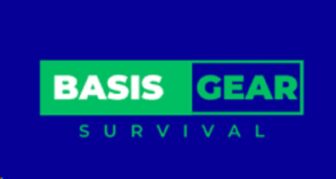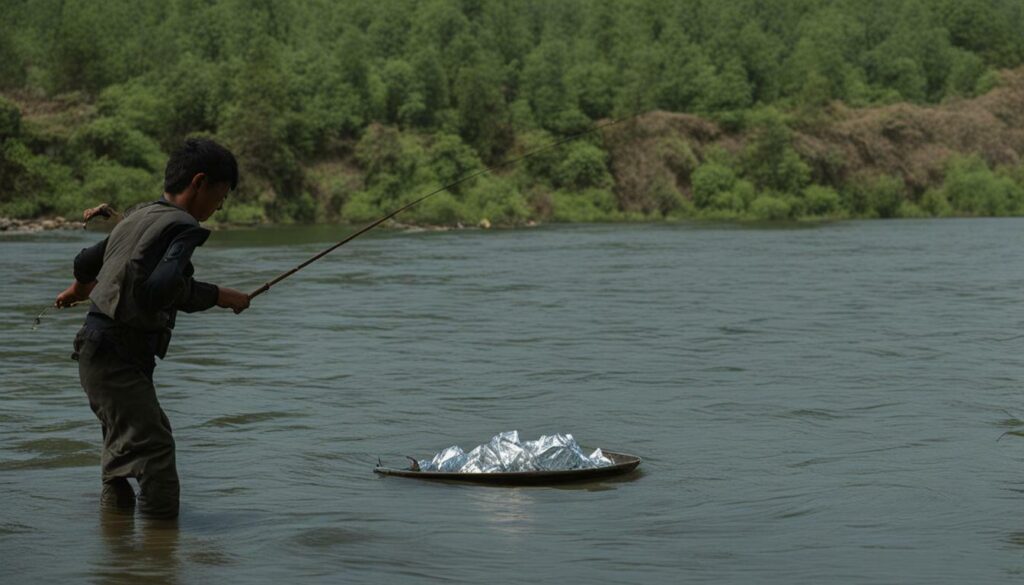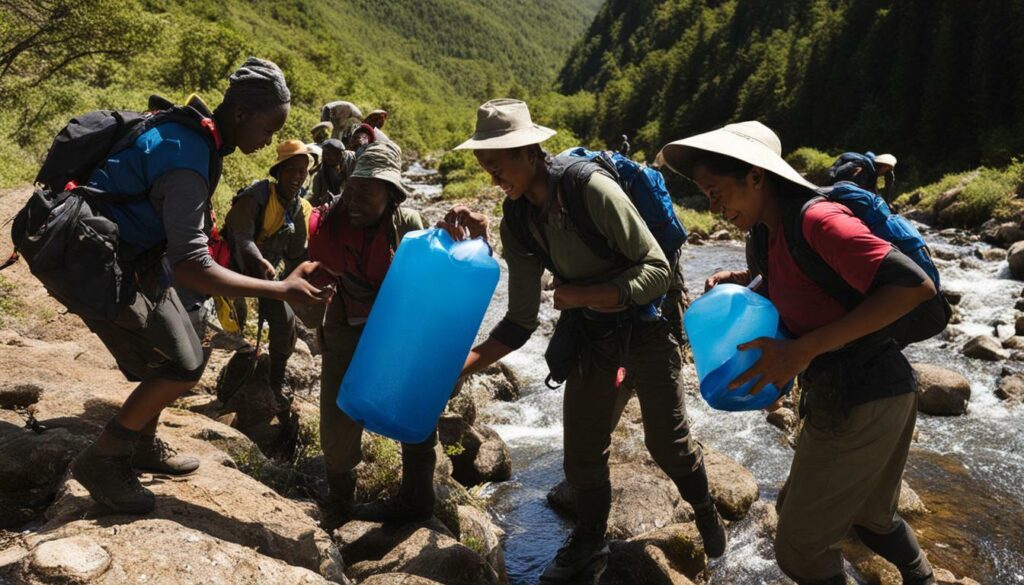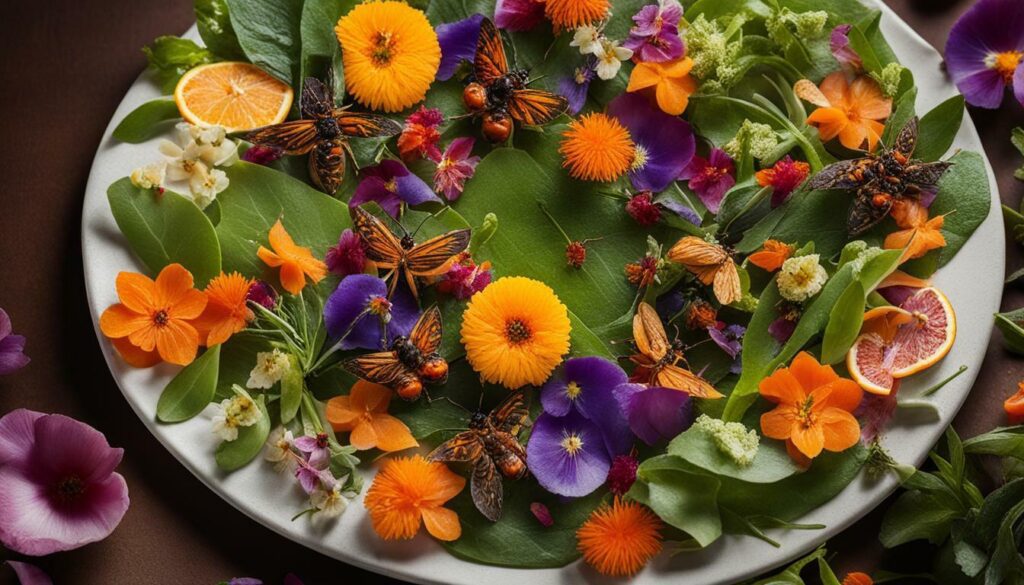In this section, I will take you on a journey into the world of foraging. If you’ve ever been curious about discovering the delicious and nutritious offerings of wild plants, then read on. I will provide you with valuable tips and guidelines to ensure a safe and enjoyable foraging experience.
Foraging is not just a way to connect with nature; it’s also an opportunity to savor the flavors of the wild. However, it’s essential to approach foraging with caution and respect for the environment. By mastering the basics of foraging and understanding the principles of wild plant safety, you can unlock a treasure trove of edible delights while preserving the balance of nature.
Edible Wild Plants Tips
- Learn the basics of foraging to enjoy the bounty of edible wild plants.
- Follow essential guidelines and safety tips for a successful foraging experience.
- Identify edible plants correctly and recognize the crucial distinction between edible and poisonous ones.
- Use reliable plant identification guides to ensure accurate identification.
- Embrace the forager’s path by practicing mindful harvesting and sustainable foraging.
Understanding Edible Plant Identification and Safety
As a forager, one of the most crucial skills you need to develop is the ability to accurately identify edible plants and distinguish them from their poisonous counterparts. This knowledge is essential for ensuring your foraging expeditions are safe and successful. In this section, we will explore the importance of understanding edible plant identification and the measures you can take to forage with confidence.
Edible vs. Poisonous: A Forager’s Crucial Distinction
Being able to differentiate between edible and poisonous plants is the foundation of safe foraging. While it might seem daunting at first, there are several key characteristics to look for when identifying edible plants:
- Study the plant’s overall appearance, including its leaves, stems, flowers, and fruits.
- Examine the plant’s growth habitat and compare it to known edible plants in your region.
- Pay attention to any distinct smells, tastes, or other sensory cues associated with edible plants.
Remember, accurate plant identification is crucial. Even a small mistake can have serious consequences. If you are unsure about a plant’s edibility, it is best to err on the side of caution and consult an expert or reliable plant identification resources.


Using an Edible Wild Plants Guide for Accurate Identification
Having access to reliable plant identification guides is a valuable tool for accurate identification. These guides typically provide detailed descriptions, photographs, and sometimes even foraging tips for various edible plants. When using a plant guide, keep the following in mind:
- Choose a guide specific to your region to ensure the plants you encounter are covered.
- Refer to multiple sources to cross-reference plant characteristics and increase accuracy.
- Be mindful of potential look-alike plants, as some edible plants may resemble poisonous ones.
Remember, accurate identification is key. Take your time, study the plants carefully, and consult reputable guides to ensure you are confidently identifying edible plants during your foraging adventures.
Embracing the Forager’s Path: Safety, Respect, and Sustainability
Foragers play a vital role in preserving the natural environment while enjoying its offerings. As foraging enthusiasts, we have the responsibility to engage in mindful harvesting and sustainable foraging practices. By following forager’s ethics and respecting foraged plants, we can ensure the continued abundance and health of our ecosystems for future generations.
Mindful Harvesting: Ensuring Safe and Respectful Foraging
Mindful harvesting is the cornerstone of responsible foraging. It involves being aware of our impact on the environment and taking steps to minimize any negative consequences. When practicing mindful harvesting, we consider factors such as the following:
- Harvesting with care and restraint to avoid overcollecting
- Choosing mature, healthy plants for harvest
- Leaving enough plants behind for their natural regeneration and the sustenance of wildlife
- Using proper tools and techniques to minimize damage to plants and their surrounding habitats
By adopting mindful harvesting practices, we can ensure that our foraging activities have a negligible impact on the environment and the plants we gather.
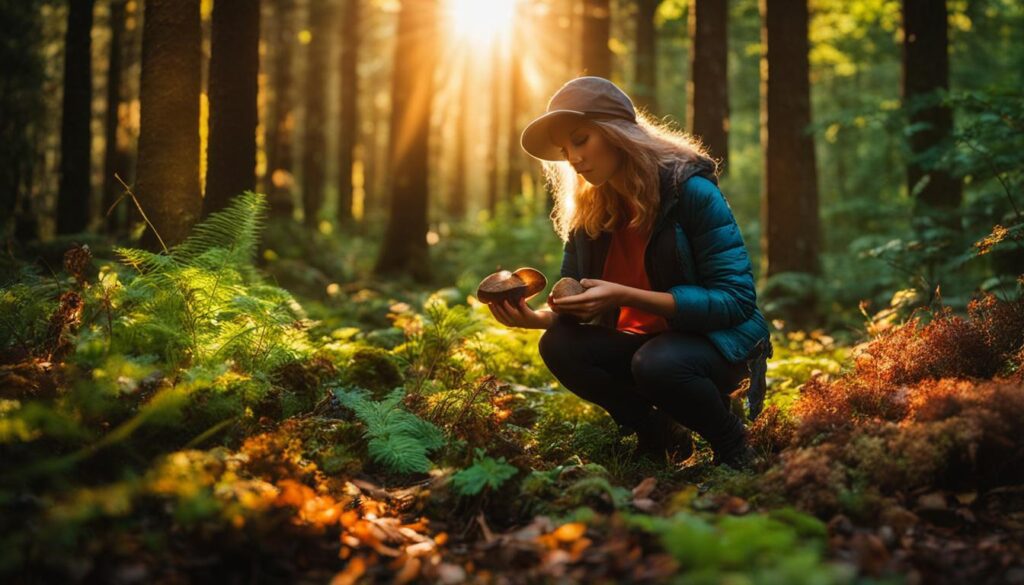

Sustainable Foraging: Protecting Nature’s Bounty for the Future
Sustainable foraging focuses on protecting and conserving our natural resources for the long term. It involves making choices that help maintain the delicate balance of our ecosystems. Here are some principles of sustainable foraging:
- Learning about the plants we forage to understand their life cycles, abundance, and distribution
- Respecting laws and regulations pertaining to foraging, such as harvest limits and protected areas
- Supporting local biodiversity by seeking a variety of wild edibles instead of relying on a few popular species
- Promoting nature conservation by actively participating in efforts to preserve and restore natural habitats
By practicing sustainable foraging, we contribute to the protection of nature’s bountiful resources and ensure their availability for future generations.
Learning to Forage: Education and Resources
Guided Foraging Tours: Learning from Experts
Embarking on a guided foraging tour is an excellent way to learn the art of foraging from knowledgeable experts. These tours provide hands-on experience and valuable insights into identifying and harvesting edible wild plants. You’ll have the opportunity to explore diverse landscapes, from forests to meadows, learning about the plants that thrive in each unique environment. Experienced guides will share their expertise, teaching you how to locate, identify, and safely gather a variety of wild edibles. This immersive learning experience will equip you with essential skills and deepen your understanding of the natural world around you.
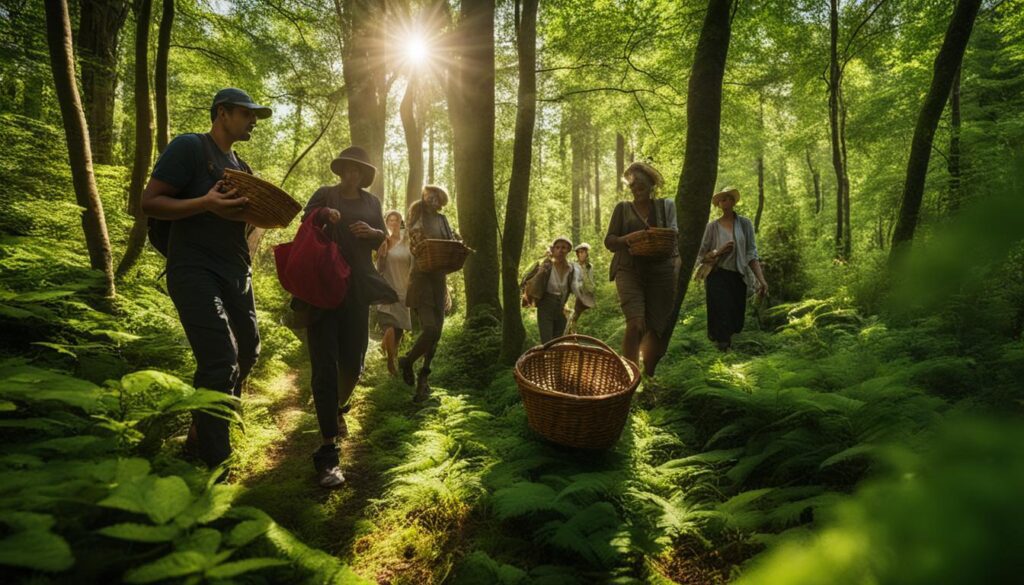

Foraging Workshops and Classes Near You
If you prefer a more structured learning approach, attending foraging workshops and classes in your local area is an excellent option. These educational opportunities often range from beginner-level classes to advanced workshops, catering to individuals with varying levels of experience. Expert instructors will guide you through the fundamentals of foraging, covering topics such as plant identification, sustainable harvesting practices, and ethical foraging principles. By participating in these workshops, you’ll gain a solid foundation in foraging techniques and develop the confidence to explore the wild on your own.
Essential Foraging Guidebooks and Tools
To enhance your foraging knowledge and journey, investing in essential foraging guidebooks and tools is highly recommended. Guidebooks provide comprehensive information on edible wild plants, including their identification, seasonality, and culinary uses. Look for reputable guidebooks authored by renowned foraging experts to ensure accurate and reliable information. Additionally, equipping yourself with the right tools, such as a sturdy knife, gathering basket, and foraging pouch, will greatly assist you in your foraging excursions. These tools will enable you to safely and efficiently harvest wild edibles while minimizing any negative impact on the environment.
Harvesting with Intent: The Ethics of Foraging for Food
Foraging is not just about gathering food; it also comes with ethical considerations. As responsible foragers, we have a responsibility to practice ethical foraging, which includes responsible harvesting and sustainable food sourcing. By doing so, we can not only enjoy the bounty of nature but also contribute to the preservation of our ecosystems.
When it comes to ethical foraging, responsible harvesting is key. It involves gathering wild plants in a way that ensures their continued growth and reproduction. This means only taking what is needed and leaving enough behind for the plant to regenerate. By practicing responsible harvesting, we can maintain the balance of plant species and ensure their long-term survival.
Sustainable food sourcing is another crucial aspect of ethical foraging. It involves making conscious choices to gather food that is sourced in an environmentally sustainable manner. This may include avoiding foraging in protected areas, not over-harvesting from the same location, and choosing plant species that are abundant and resilient. By actively considering the sustainability of our food sources, we can minimize our impact on the natural environment and promote biodiversity.


Foraging Kits: Tools and Equipment Essentials
Having the right tools and equipment is essential for a successful and enjoyable foraging experience. Whether you’re a beginner or an experienced forager, packing the right gear can make a significant difference in your foraging trip. In this section, I will discuss what to pack on your foraging excursion, including must-have items for the beginner forager. I will also provide recommendations for foraging kits, tools, and other essentials.
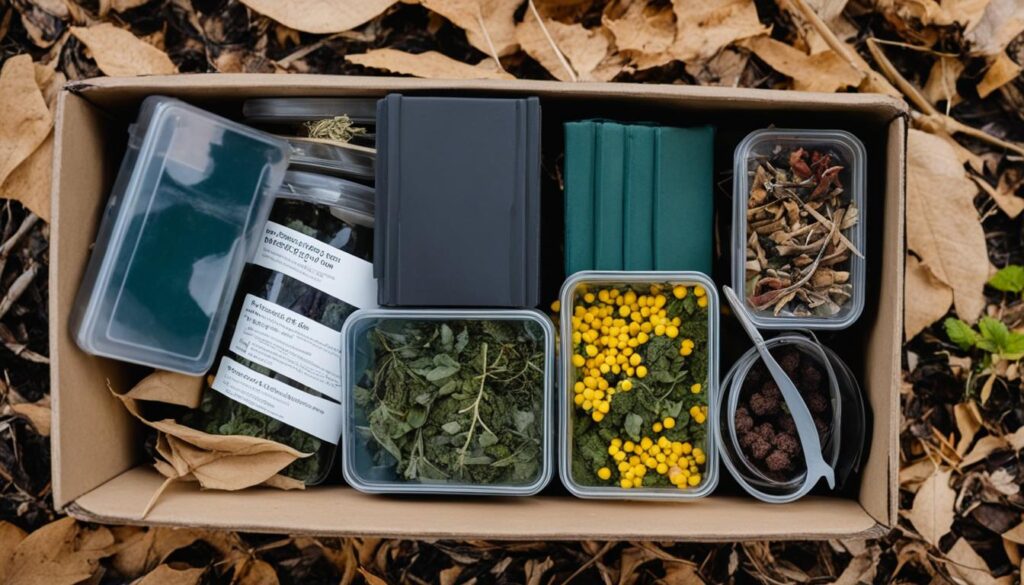

What to Pack on Your Foraging Excursion
Before heading out on your foraging adventure, it’s important to pack the right essentials. Here are some items you should consider including in your foraging kit:
- A sturdy backpack or foraging bag to carry your supplies
- Comfortable and durable clothing suitable for the weather and terrain
- Sturdy footwear for walking and protection
- A hat and sunscreen to protect against the sun
- A first aid kit for minor injuries or emergencies
- A field guide or foraging app for plant identification
- A notebook and pen for taking notes or sketching plants
- Reusable containers or bags for collecting your foraged treasures
- A small knife or scissors for harvesting plants
- Gloves for handling prickly or thorny plants
Must-Haves for the Beginner Forager
If you’re new to foraging, it’s essential to start with the right tools and equipment. Here are some must-have items for the beginner forager:
- A good-quality foraging knife with a sharp blade
- A sturdy foraging basket or bag with compartments for organizing your finds
- A pair of gardening gloves for protection
- A magnifying glass for closer plant examination
- A small trowel or garden fork for digging up roots or bulbs
- A compass or GPS device for navigation
- An extra set of clothes and shoes in case of unexpected weather or muddy conditions
- A field guide specifically tailored for your region
- Water bottles or a hydration pack to stay hydrated
Remember, it’s important to do your research and familiarize yourself with local regulations and restrictions before foraging in any area. Respect the environment and practice sustainable foraging to ensure the preservation of plant populations for future generations.
Edible Wild Plants: A Treasure Trove of Nutrition
Wild edible plants offer a wealth of nutritional benefits. Foraging for these wild plants not only connects us with nature but also provides us with a diverse array of nutrients to support our health and well-being. From vitamins and minerals to antioxidants and fiber, wild edibles are a valuable addition to a healthy diet.
The Nutritional Value of Popular Edible Wild Plants
Wild edible plants are packed with essential nutrients that can contribute to our overall health. The nutritional composition of wild plants can vary depending on the species, but they often contain high levels of vitamins A, C, and K, as well as minerals like iron, calcium, and magnesium.
One of the unique aspects of wild edibles is their rich antioxidant content. Antioxidants help protect our cells from damage caused by harmful free radicals, thereby reducing the risk of chronic diseases such as heart disease and cancer.
In addition to antioxidants, wild plants are often abundant sources of dietary fiber. Fiber is essential for maintaining a healthy digestive system, regulating blood sugar levels, and supporting heart health.
Furthermore, wild plants can provide a variety of flavors and textures that can enhance the enjoyment of our meals and provide a culinary adventure.
Wild Plant Nutrition vs. Store-Bought Veggies
When comparing the nutritional value of wild edibles to store-bought vegetables, there are some key differences to consider. While store-bought vegetables are generally cultivated to maximize yield and appearance, wild edibles grow in their natural environment and adapt to the specific conditions, which can result in higher nutrient concentrations.
Wild plants are also less likely to be subjected to pesticides and other chemical treatments commonly used in commercial agriculture. This can make them a safer and more natural choice for those seeking organic and pesticide-free options.
However, it’s important to note that the nutritional content of wild edibles can vary depending on factors such as the soil composition and growing conditions. It’s advisable to forage from clean and safe areas and to properly identify plants to ensure they are indeed edible.
When incorporating wild edibles into our diet, it’s recommended to combine them with a diverse range of store-bought vegetables to ensure a well-rounded and balanced nutritional intake.
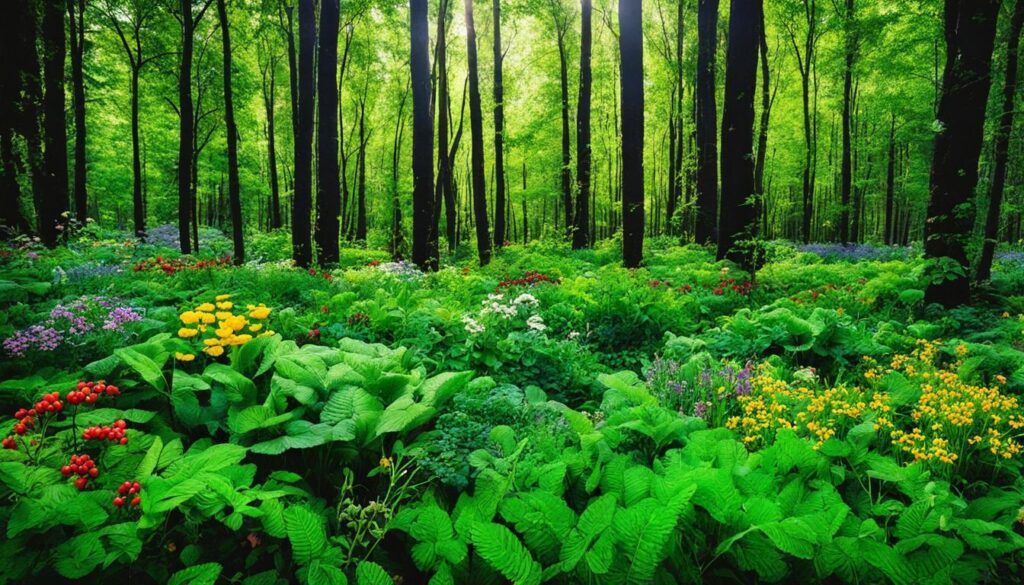

Overall, edible wild plants offer a treasure trove of nutrition, providing us with a wide range of vitamins, minerals, antioxidants, and dietary fiber. They bring diversity and unique flavors to our meals, making them an exciting addition to any diet. However, it’s essential to approach foraging with caution, ensuring proper plant identification and harvesting from safe areas. By incorporating wild edibles alongside store-bought vegetables, we can create a nutritionally rich and satisfying diet.
Foraging Throughout the Seasons: What to Gather When
Foraging opportunities vary throughout the seasons, with each offering its own unique selection of edible plants. In this section, I will provide a guide on foraging throughout the seasons, highlighting what to gather during each time of the year. We’ll explore the seasonal availability of wild edibles and the best times to harvest them.
When it comes to foraging, timing is everything. Each season presents different opportunities to discover and gather nature’s bounties. Here’s a breakdown of what to look for in each season:
Spring
In spring, the earth awakens, and a vibrant array of wild edibles emerge. This is the time to gather fresh greens, such as dandelion greens, nettle, and chickweed. Look for tender shoots like ramps and wild garlic, as well as early flowers like violets and daisies. Spring is also the season for delicate mushrooms like morels.
Summer
As summer arrives, the foraging possibilities expand even further. This is the season for berries, including wild raspberries, blackberries, and blueberries. Keep an eye out for edible flowers like elderflowers and daylilies. Nuts, such as hazelnuts and acorns, start to ripen, providing a rich source of nutrition. You may also find wild edible mushrooms like chanterelles.
Fall
Fall is a bountiful time for foragers. It’s when you’ll find an abundance of mushrooms, including the sought-after porcini and hen of the woods. Nut trees, such as walnuts and chestnuts, offer their treasures. Fall is also the season for foraging wild apples, pears, and persimmons. Don’t forget to gather autumn berries like rosehips and hawthorn berries.
Winter
Despite the colder temperatures, winter still offers foraging opportunities. This is the time to seek out evergreen needles for making tea, such as pine, spruce, and fir. Look for winter foraging delicacies like wild wintergreens and frost-kissed sweet potatoes. Also, keep an eye out for frozen fruits, such as grapes, that can add flavor to savory dishes.
Remember, always forage responsibly and respect nature’s balance. Only gather what you need and leave enough for the plants to regenerate and provide food for wildlife. Happy foraging!
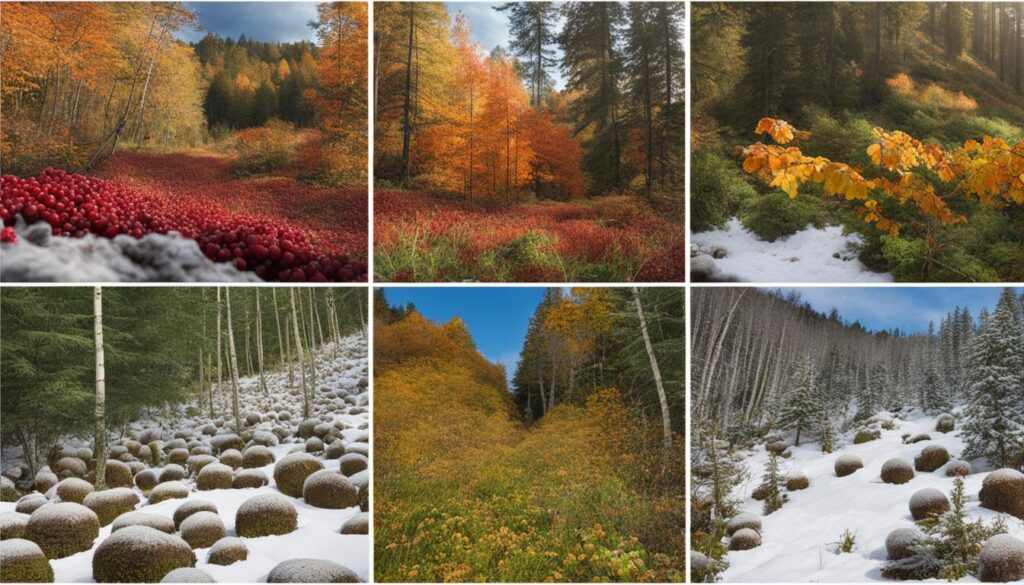

Conclusion
In conclusion, foraging offers a wonderful opportunity to connect with nature and enjoy the flavors of edible wild plants. Throughout this article, we have explored the basics of foraging and the importance of safe and respectful practices.
By understanding the crucial distinction between edible and poisonous plants, using reliable identification guides, and practicing mindful harvesting, foragers can ensure a safe and rewarding experience. It is also essential to prioritize sustainability and protect the natural environment by only harvesting what is needed and leaving enough for the ecosystem to thrive.
As you embark on your own foraging journey, remember to pack your essentials, such as a foraging kit and reliable tools, and educate yourself through guided tours, workshops, and guidebooks. By doing so, you can enhance your knowledge and make the most of your foraging expeditions.
So, whether you are venturing into the woods in search of delicious treats or tending to a backyard garden filled with wild edibles, embrace the forager’s path with responsibility and respect. Take delight in the treasures that nature provides and savor the bountiful offerings of edible wild plants while helping to preserve our natural world for future generations.
FAQ
What are some basic foraging tips for beginners?
Some basic foraging tips for beginners include starting with easy-to-identify plants, learning from experienced foragers, using reliable plant identification guides, and avoiding areas with potential contamination.
How can I differentiate between edible and poisonous plants?
It is crucial to be able to identify edible plants correctly. Some key distinctions include examining leaf shape, texture, and arrangement, as well as observing flower and fruit characteristics. Reliable plant identification guides are essential to ensure accurate identification.
What is the importance of mindful harvesting in foraging?
Mindful harvesting is essential for safe and respectful foraging practices. It involves not over-harvesting wild plants, taking only what is needed, and leaving enough for future growth and for other foragers. It also means considering the impact on the ecosystem and the overall sustainability of the foraging activity.
Where can I learn to forage?
There are several avenues to learn to forage, including joining guided foraging tours led by experts, attending local workshops and classes, and self-education through books and online resources. Each option offers unique opportunities to learn from experienced foragers and enhance your foraging skills.
What are the ethical considerations in foraging for food?
Ethical foraging practices include responsible harvesting, which means not taking more than necessary and avoiding harm to the plant and its surrounding habitat. Sustainable food sourcing is also essential, as it involves considering the long-term impact on the ecosystem, preserving biodiversity, and supporting the balance of the natural environment.
What tools and equipment do I need for foraging?
Some essential tools and equipment for foraging include a sturdy harvesting knife or scissors, a foraging basket or bag to collect your finds, a field guide or smartphone app for plant identification, and protective gear such as gloves and a hat. It is also helpful to have a comfortable backpack for carrying your supplies.
What nutritional benefits do wild edible plants provide?
Wild edible plants offer a wealth of nutrition, including vitamins, minerals, antioxidants, and dietary fiber. They often have higher nutrient levels compared to store-bought vegetables due to their wild growth and the diversity of their natural environment.
Which wild edible plants are available during different seasons?
The availability of wild edible plants varies throughout the seasons. For example, in the spring, you may find wild greens like dandelion and chickweed. In the summer, berries and fruits become abundant, while in the fall, nuts and mushrooms are more prevalent. Winter is often a season for roots and tubers. It is important to learn about the specific plants that grow in your region and their seasonal patterns.
